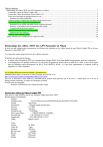Video conversion is performed in the YUV color space; you can choose to scale video to any frame size using a professional 2D-FIR scaler (better than bicubic) but you can also leave it unscaled. Other optional video processing features include a powerful motionadaptive deinterlacer, a field dominance converter, a chroma reinterlacer and an option to perform interlaced scaling instead of progressive scaling. Audio can be converted to uncompressed or to IMA, AAC, MP2 or AMR using the high-quality
MP1/MP2/AC3/PCM built-in decoders of MPEG Streamclip; it is also kept in perfect sync with video using a timekeeping system.
MPEG Streamclip can save edited movies as MOV files, and (when possible) as AVI or MP4 files. Edited MPEG-1 or MPEG-2 files are saved as MPEG or TS files.
MPEG Streamclip can also convert MPEG-2 transport streams into muxed MPEG-2 files, for immediate burning at full quality with most DVD authoring applications; it can also demux MPEG-1 and MPEG-2 files and transport streams with MPEG, AC3, PCM audio to M2V and AIFF (or M1A or AC3) files, for immediate burning at full quality with DVD authoring applications. A special demuxing option is available for use in QuickTime Pro: this application does not work well with M2V files, but MPEG Streamclip can write a special "unscaled" M2V file that preserves full video quality.
MPEG Streamclip can handle files and streams larger than 4 GB, split in any number of segments, or with multiple audio tracks, and can also optionally handle timecode breaks. It is compatible with MPEG-1 and MPEG-2 video, MPEG layer 1/2 (MP1/MP2) audio,
AC3/A52 audio, and PCM audio.
The player included in MPEG Streamclip lets you preview the files and transport streams before doing the conversion; it also lets you visually set the In and Out points for the conversion so you can convert just the part of the file you are interested in, and also cut commercials and other unwanted parts, or edit the stream and join two streams with Cut/Copy/Paste.
Il comprime bien, garde la synchronisation son / image, et il est simple à utiliser.
Par contre, problème pour la rotation: avec les réglages par défaut, l'image tourne mais pas le cadre.
Solution pour les rotations:
http://forums.macgeneration.com/video/imovie-rotation-de-video-137035.html http://forum.macbidouille.com/index.php?act=Print&client=printer&f=4&t=210982
Voir surtout le manuel en français: http://forum.mac-video.fr/articles/MPEGStreamclip/Guide.html#Rotation
Voila les paramètres pour une rotation des fichiers 848x480 du Panasonic Lumix DMC-LZ7:
Le 184 du crop provient de : (848 - 480) / 2 = 184
Normalement, quand on donne un "Limit data rate", le curseur "Quality" ne devrait pas être pris en compte.
Sans cocher "Limit data rate": un Quality de 50% donne un flux vidéo de 800kbps environ un Quality de 60% donne un flux vidéo de 1800kbps environ
Pour une vidéo 640x480 , utiliser 80 à la place de 184 :
(640 - 480) / 2 = 80

